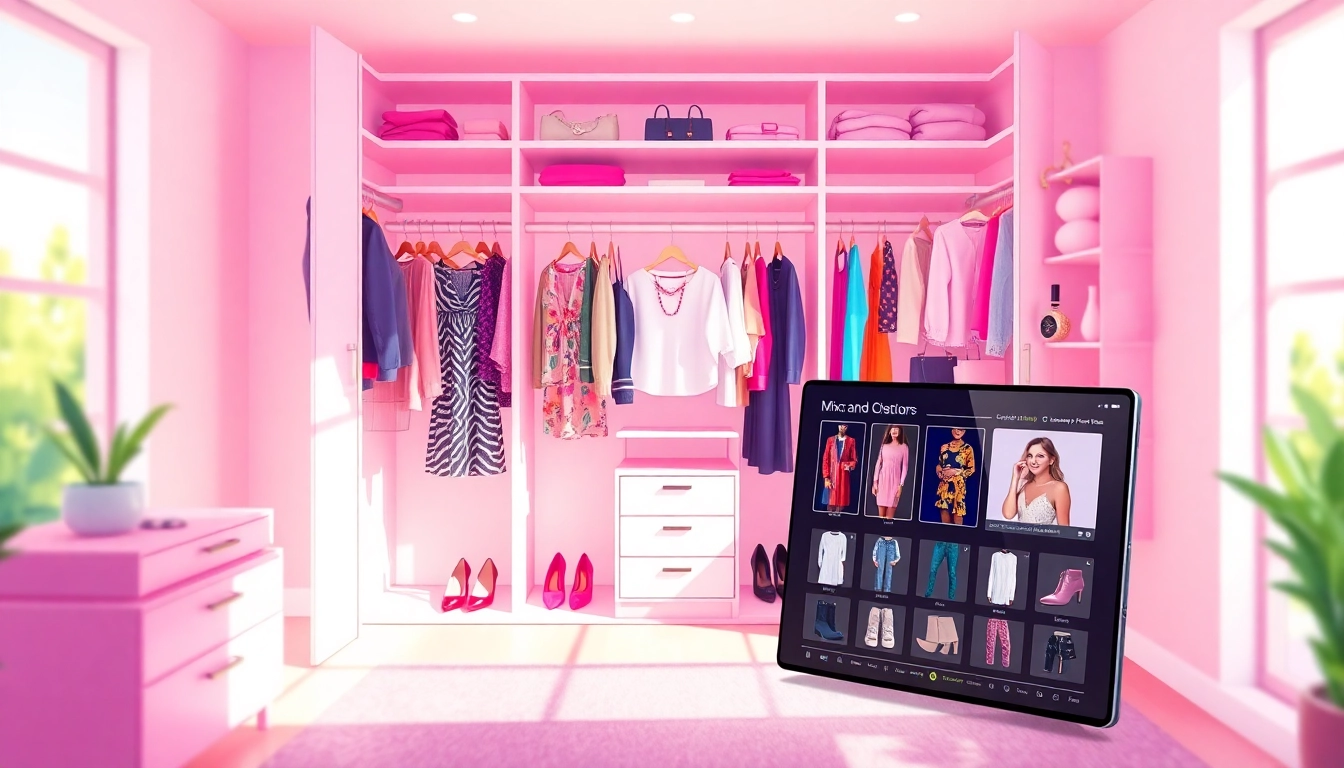Understanding Cher’s Clueless Closet Concept
In the iconic 1995 film Clueless, the character Cher Horowitz, played by Alicia Silverstone, captivated audiences not only with her charm and wit but also with her remarkable digital closet. The concept of Cher’s clueless closet represents a profound vision of fashion and technology intertwining seamlessly. Today, we explore the origins, defining features, and the evolution of wardrobe solutions inspired by this seminal film.
Origins in Film and Culture
The character Cher exemplifies the quintessential ‘90s teen—confident, stylish, and ahead of her time. Cher’s closet was revolutionary: a digitally managed wardrobe that helped her curate outfits based on various criteria. This fictional closet sparked a cultural phenomenon, symbolizing not just fashion but also the integration of technology in our everyday lives. As viewers, we admired the ease with which Cher mixed and matched different items, setting the stage for a new era in personal styling.
Features that Defined the Closet
Cher’s wardrobe boasted a user-friendly interface that gave her an overview of her entire collection. Key features included:
- Digital Inventory: Every piece of clothing was cataloged, allowing her to see what she owned at a glance.
- Automated Outfit Generation: Cher could create outfits based on weather, occasion, or personal style with ease.
- Visual Interaction: The closet featured a graphical display, making wardrobe management not only practical but also visually appealing.
With these features, Cher revolutionized the way teenagers viewed fashion, turning the act of getting dressed into an enjoyable experience fueled by technology.
The Evolution of Wardrobe Solutions
Following the release of Clueless, innovators took inspiration from Cher’s closet to develop real-world applications that mirrored her style. These solutions have evolved with technology, paving the way for digital wardrobe management to become mainstream. Today, applications allow users to upload images, categorize their wardrobes, and generate outfits similar to how Cher navigated her closet. The influence of Cher’s digital closet can be seen in modern apps designed for wardrobe organization, styling tips, and personal fashion assistant services.
Designing Your Own Digital Closet
As the trend of virtual closets continues to flourish, many people wish to replicate the charm and functionality of Cher’s clueless closet. Designing your own digital closet requires thoughtful planning to create a seamless user experience.
Key Functionalities to Include
To replicate the essence of Cher’s closet, consider implementing these core functionalities:
- Inventory Management: Allow users to photograph and catalog items into their digital closet.
- Outfit Planning: Provide algorithms that suggest outfits based on user preferences and occasions.
- Seasonal Updates: Adapt the closet to suggest items based on weather conditions or seasons.
These features will create an engaging experience that keeps users coming back to their digital closets.
User Engagement and Interactivity
User engagement is paramount in ensuring that a digital closet not only serves its purpose but also delights its users. Incorporating interactive elements such as:
- Outfit Sharing: Allow users to share their styled outfits via social media.
- Feedback Mechanism: Enable users to rate outfit suggestions and provide feedback for future improvements.
- Virtual Try-Ons: Integrate augmented reality features for users to virtually try on outfits before finalizing their look.
These interactive components enhance the user experience, making wardrobe management feel more personalized and fun.
Incorporating Fashion Trends
A successful digital closet is not static; it adapts to ever-changing fashion trends. Implementing a feature that allows users to follow current trends and receive updates on new styles and colors can keep the closet relevant and exciting. Curating personalized style feeds based on users’ previous choices can provide inspiration for future outfits, ensuring that Cher’s visionary closet lives on in a modern context.
How Cher’s Clueless Closet Influenced Fashion Apps
The impact of Cher’s clueless closet extends far beyond its cinematic origins; it has shaped the landscape of fashion apps that we see today. As digital innovation continues to evolve, many applications emerged that mirror the functionalities of Cher’s closet.
Pioneers in Digital Wardrobe Solutions
Countless fashion apps have adopted the concept of a digital wardrobe. Some pioneers include:
- Virtual Stylist Apps: These reduce the time spent deciding what to wear by providing users with outfit suggestions.
- Closet Organization Tools: Platforms encouraging users to keep track of their wardrobes promote sustainable fashion practices.
- Social Fashion Networks: Applications that promote sharing and collaboration among users, allowing for a community-driven fashion experience.
These pioneers have taken inspiration from the iconic features of Cher’s closet to create highly interactive and user-friendly platforms that instill confidence in personal styling.
Fashion Industry Response
The fashion industry’s response to the digital closet phenomenon reflects a growing acceptance of technology in daily attire choices. Many brands have begun to harness digital solutions designed to streamline the shopping experience. E-commerce sites leverage virtual styling features to offer personalized recommendations based on user profiles, reflecting the same intuitive understanding that Cher’s closet embodied.
User Testimonials and Case Studies
Real-world examples of users benefitting from digital closet applications showcase the effectiveness and popularity of these tools. Individuals report feeling more organized, less stressed about their outfits, and more inspired by their personal style. Case studies have highlighted how styling tools have empowered users to shop more sustainably, encouraging them to rethink their consumption habits and invest in quality over quantity.
Overcoming Challenges in Closet Management
While the concept of a digital closet offers numerous benefits, challenges persist in managing virtual wardrobes effectively. Identifying common issues and providing actionable solutions can enhance user experience significantly.
Common User Queries and Solutions
Users often encounter difficulties such as overcrowded inventories, difficulty categorizing items, or frustration in finding pieces quickly. Addressing these issues involves:
- Simplified Categorization: Use automatic tagging systems based on color, brand, occasion, and style.
- Search Functionality: Implement advanced search filters to allow users to locate clothing items rapidly.
- Regular Maintenance Reminders: Encourage users to update their wardrobe and remove items that are no longer used.
By implementing these solutions, users can enjoy a smoother experience, akin to Cher’s effortless interaction with her closet.
Best Practices for Virtual Wardrobe Organization
To maximize the effectiveness of a digital closet, users should adhere to best practices such as:
- Regular Updates: Schedule regular intervals to review and tidy the virtual closet.
- Utilize Outfit Planning: Plan outfits ahead of time, especially for special occasions.
- Document Past Outfits: Keep a visual record of outfits worn to avoid repetition in ensembles.
These practices help users maintain a cohesive and functional digital wardrobe, ensuring they can enjoy fashion without difficulty, just as Cher did.
Technology Trends in Fashion Management
Technology in fashion management is continually evolving. Future innovations might include:
- Artificial Intelligence: To provide personalized recommendations based on user data and preferences.
- Blockchain for Authenticity: To ensure users have access to genuine items and to promote ethical fashion.
- Mobile Integration: Streamlining the fashion experience through app integrations with smart devices.
These advancements will further refine the concept of a digital closet, making it more intuitive and transparent for users.
The Future of Cher’s Clueless Closet Concept
As we look ahead at the future of digital wardrobes, it is critical to examine anticipated innovations and the impact these will have on sustainability and user experience.
Anticipated Innovations and Upgrades
Future innovations may include:
- Enhanced User Interfaces: More intuitive and visually appealing designs to engage users further.
- AR and VR Technology: Virtual reality shopping experiences that could revolutionize the way we try on clothes.
- Collaborative Wardrobes: Features that allow users to share items with friends or family seamlessly.
The ongoing evolution of technology will likely forge new pathways for digital wardrobe management, enhancing user engagement with fashion choices.
Impact on Sustainable Fashion Choices
Today’s environmental consciousness is prompting users to rethink fashion consumption. Digital closets can promote sustainable behaviors by encouraging:
- Wardrobe Recycling: Users can donate, sell, or swap items directly through apps.
- Environmental Awareness: Providing information about clothing sources and sustainability ratings.
- Minimalist Trends: Tools that promote capsule wardrobes, encouraging users to create fewer, more versatile outfits.
Such features not only promote sustainability but also empower users to become more mindful about their fashion choices, reflecting Cher’s own journey toward self-awareness and style.
Bridging Digital and Physical Closet Experiences
The future of Cher’s closet may lead to hybrid experiences, merging digital capabilities with physical closet management. Innovative ideas include:
- Smart Closet Technology: Incorporating sensors into physical closets that sync with digital apps, automating organization.
- Interactive Displays: Using screens in closets to help users visualize outfits and receive styling tips.
- Wearable Fashion Tech: Devices that assess how often clothing is worn and suggest rotations to maximize use.
These developments will help create a more fluid relationship between physical and digital closets, ensuring that users can access their style preferences effortlessly.
In conclusion, Cher’s digital closet not only rewrote the narrative of personal styling but also set the foundation for future technological innovations in fashion. From registered inventory management to AI-driven outfit suggestions, the spirit of Cher’s clueless closet lives on in the applications we now frequently use. By embracing the evolution of wardrobe solutions, we take significant steps toward a more stylish, engaged, and sustainable future.



